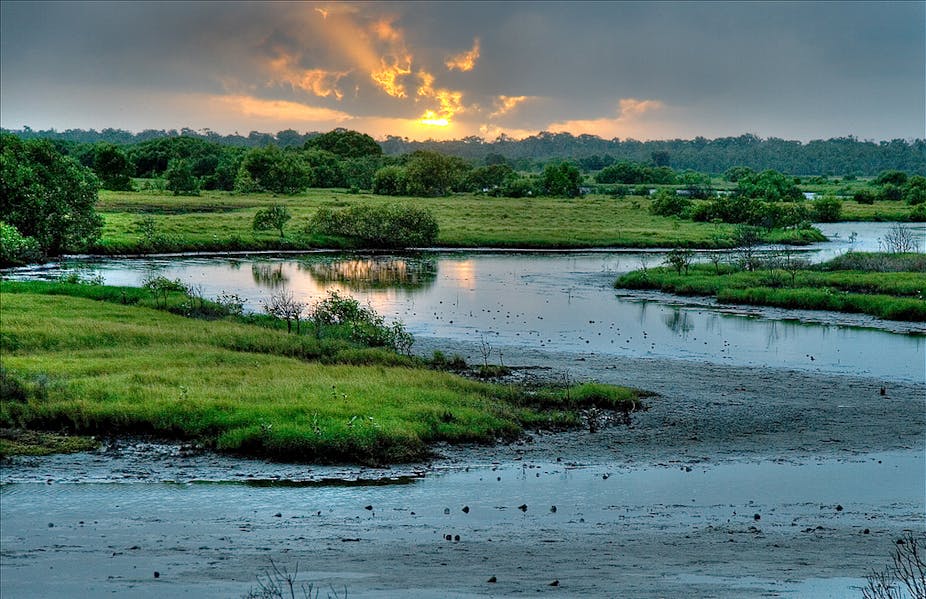UNESCO has released its latest report on the state of the Great Barrier Reef, and has once again raised concerns about excessive port development along the coast, and the state of water quality around the reef.
In March I was invited to Queensland to see for myself the threat posed by proposed massive port expansions along the Great Barrier Reef.
I flew over Abbott Point to examine the present coal terminal. We visited the adjacent Caley Valley Wetlands in a tinny, revealing dozens to hundreds of birds at every creek turn. Huge flocks of whistling ducks took flight as we approached, herons perched in trees or stalked among water lilies; we saw great pelicans, magpie geese, kingfishers, elegant long-necked cormorants, kites, and half a dozen other species of duck, rails and black swans. The density of birds was astonishing, the highest I have ever seen in any wetland. It was immediately clear that this was an extraordinary haven for wildlife.
The present coal terminal and connecting road and rail links follow the southern side of the wetlands to a long loading jetty. This infrastructure is large and has clearly had a significant impact, but there is much intact and unspoiled wetland left. The plan is to expand the port to become the largest coal terminal in the world; that expansion would be the end for these wetlands. The impacts on the Great Barrier Reef directly would also be considerable: millions of tonnes of dredge material are likely to be dumped near Holbourne Island and its coral reefs, with potential for much greater dispersal further offshore.
Further south we travelled by boat from Yeppoon to Gladstone. The Fitzroy River delta is one of the wonders of this coastline. Approached by sea, it probably looks much as it did when Captain Cook sailed by more than 200 years ago.
People tend to develop estuaries wherever they find them. They have lots of low-lying land to build on, easy access to the ocean and plentiful water to flush away waste. Given this long historical association, there are very few of the size and importance of the Fitzroy that are left undeveloped. This means the estuary is as significant, extraordinary and precious as the Great Barrier Reef itself. If it is destroyed it cannot be recovered. Yet it is deeply threatened by proposals for a massive new port.
The importance of the estuary is underlined by the presence of endangered and iconic species, such as a small and genetically distinct resident population of snub fin dolphin.
Travelling south we encountered the mangrove-laced Narrows, flushed by powerful tidal currents that promote high productivity and attract large animals like bull sharks and even occasional crocodiles. The northern section, like the Fitzroy Delta to which it is connected, is undeveloped and has a timeless quality about it. On the southern stretch, construction cranes and the silhouettes of bulk carrier ships loom, soon merging into a relentless string of industrial constructions.
I have never seen such a sprawling port. Every company appears to have its own separate facility, so that Gladstone is more like a collection of many ports than a single entity. There seems to have been little need to build gas hubs on the world heritage-listed Curtis Island, had land been used more wisely. Images taken before dredging operations opened up the Curtis Island jetties revealed that dredging hadn’t just deepened and widened channels, it had removed the entire network of shallow wetlands.
Gladstone’s wasteful sprawl now threatens more of Curtis Island as well as the Fitzroy Delta.
I doubt that many Queenslanders or other Australians realise what they are about to lose: the wild open spaces, places for recreation, inspiration and fun, and habitats that sustain the wider ecology of the coast, support significant fisheries and protect the Great Barrier Reef.
Wetlands along the coast are vital to the survival of the Great Barrier Reef region. They are the reef’s first line of defence from adverse terrestrial influences, retaining and trapping sediments and nutrients that would otherwise be moved offshore to stress and damage corals. They help limit the spread of flood waters, which will be an increasingly important function in the future as the climate changes. And they provide nurseries for many commercially important species of fish like prawns, snappers and emperors.
I was alarmed by the enormous threats to the unspoiled coastal environment and quality of life for Australians; one cannot ignore the global significance of the Queensland coast, the role of intact, healthy habitats in the economic prosperity of the region, and the interdependent nature of the entire coast to the outer reef region - you can’t damage one part without damaging others.
Visiting these amazing places first-hand has revealed to me how mining interests are prepared to squander the future of many to enrich just a few in the present. Open spaces and unspoiled country are the soul of Australia, embedded in the national psyche. But there is a real danger that Australia is selling its soul to the mining industry.
The World Heritage Committee was wise to send a mission to investigate. The risk to the Reef is profound.
Coastal wetland protection and protection of the Reef from port expansion, dredging and shipping are fundamentally intertwined. Without a swift change of direction, Queenslanders and the world risk ruining a living priceless treasure.

